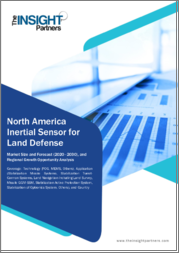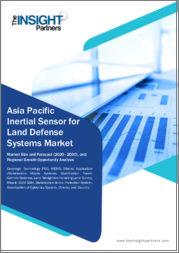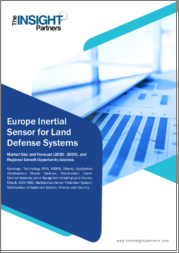
|
시장보고서
상품코드
1603520
세계의 군용 센서 시장 규모, 점유율, 성장 분석, 유형별, 플랫폼별, 용도별, 지역별 시장 규모, 점유율, 성장 분석 - 산업 예측(2024-2031년)Military Sensors Market Size, Share, Growth Analysis, By Type (Imaging Sensors, Seismic Sensors), By Platform (Airborne, Land), By Application, By Region - Industry Forecast 2024-2031 |
||||||
군용 센서 세계 시장 규모는 2022년에 104억 8,000만 달러로 평가되었습니다. 2023년 111억 달러에서 2031년에는 175억 6,000만 달러로 성장하고, 예측 기간(2024-2031년) 연평균 복합 성장률(CAGR)은 5.90%를 나타낼 전망입니다.
군사 및 항공 분야에서는 첨단 센서 기술의 통합이 눈에 띄게 발전하고 있습니다. 국방 시스템, 특히 정보, 감시 및 정찰(ISR) 장비는 원격지에서 실시간으로 데이터를 전송하는 무선 네트워크에 대한 의존도가 높아져 국경에서의 작전 효과를 높이고 있습니다. 최신 항공기에는 압력 및 온도 센서부터 가속도계, 레이더 시스템까지 다양한 센서가 탑재되어 있으며, 그 기능은 매우 중요한 역할을 하고 있습니다. 보안 시스템에서 지능형 센서 기술의 중요성이 높아짐에 따라 군사 작전에서 지능형 센서 기술이 중요한 역할을 하고 있음을 알 수 있습니다. 마이크로 전자기계 시스템(MEMS)의 발전으로 마이크로 자이로, 마이크로 볼로미터, 마이크로 미러와 같은 MEMS 기반 장치의 채택이 증가함에 따라 시장 성장에 큰 영향을 미치고 있습니다. 또한, 여러 국가에서 진행 중인 군사 현대화 이니셔티브는 시장 확대를 더욱 촉진할 것으로 예상됩니다. 결과적으로 첨단 센서 기술과 현재 진행 중인 국방 업그레이드의 상호 작용으로 인해 군용 센서 시장은 가까운 미래에 크게 성장하여 현대 전쟁 및 국방 전략의 진화하는 수요를 충족시킬 수 있을 것으로 예상됩니다.
목차
서론
- 조사 목적
- 조사 범위
- 정의
조사 방법
- 정보 조달
- 2차 데이터와 1차 데이터 방법
- 시장 규모 예측
- 시장 전제조건과 제한
주요 요약
- 세계 시장 전망
- 공급과 수요 동향 분석
- 부문별 기회 분석
시장 역학과 전망
- 시장 개요
- 시장 규모
- 시장 역학
- 성장 촉진요인과 기회
- 성장 억제요인과 과제
- Porter's Five Forces 분석과 영향
- 경쟁 기업간 경쟁 관계
- 대체품의 위협
- 바이어의 교섭력
- 신규 진출업체의 위협
- 공급 기업의 교섭력
주요 시장 인사이트
- 중요 성공 요인
- 경쟁 정도
- 주요 투자 기회
- 시장 생태계
- PESTEL 분석
- 거시경제 지표
- 시장의 매력 지수
- 밸류체인 분석
- 규제 분석
- 가격 분석
- 무역 분석
- 이용 사례 분석
- 기술 분석
- 특허 분석
군용 센서 시장 규모 : 유형별&CAGR(2024-2031년)
- 시장 개요
- 이미징 센서
- 지진 센서
- 음향 센서
- 자기 센서
- 압력 센서
- 온도 센서
- 토크 센서
- 속도 센서
- 레벨 센서
- 플로우 센서
- 힘 센서
- AOA 센서
- 첨단 카즈 센서
- 위치 또는 변위 센서
- 가속도계
- 자이로스코프
- GPS 센서
- 근접 센서
- 기타
군용 센서 시장 규모 : 플랫폼별&CAGR(2024-2031년)
- 시장 개요
- 항공
- 전투기
- 헬리콥터
- 특수 임무 항공기
- 무인항공기
- 육상
- 장갑차량
- 전투 지원 차량
- 무인지상차량(UGV)
- 사업 거점
- 솔져 시스템
- 해양
- 전투함
- 전투 지원선
- 잠수함
- 무인 해양 차량(UMVS)
- 위성
- 군수품
- 로켓 및 미사일
- 유도탄
- 어뢰
- 포병 시스템
군용 센서 시장 규모 : 용도별&CAGR(2024-2031년)
- 시장 개요
- 정보 감시 정찰(ISR)
- 통신 및 내비게이션
- 전투 작전
- 전자전
- 타겟 인식
- 지휘 및 통제
- 무기 및 사격 관제
- 웨어러블
- 사이버 보안
- 시뮬레이션 및 트레이닝
- 엔진 및 오퍼레이션 시스템
군용 센서 시장 규모 : 지역별&CAGR(2024-2031년)
- 북미
- 미국
- 캐나다
- 유럽
- 영국
- 독일
- 스페인
- 프랑스
- 이탈리아
- 기타 유럽
- 아시아태평양
- 중국
- 인도
- 일본
- 한국
- 기타 아시아태평양
- 라틴아메리카
- 브라질
- 기타 라틴아메리카
- 중동 및 아프리카
- GCC 국가
- 남아프리카공화국
- 기타 중동 및 아프리카
경쟁 정보
- 주요 5개사 비교
- 주요 기업의 시장 포지셔닝(2023년)
- 주요 시장 기업이 채택한 전략
- 시장 최근 동향
- 기업의 시장 점유율 분석(2023년)
- 주요 기업 개요
- 기업 개요
- 제품 포트폴리오 분석
- 부문별 점유율 분석
- 매출 전년대비 비교(2021-2023년)
주요 기업 개요
- Honeywell International Inc.(US)
- TE Connectivity Ltd.(Switzerland)
- Raytheon Technologies(US)
- Lockheed Martin(US)
- Thales(France)
- Kongsberg Gruppen(Norway)
- Ultra Electronics(UK)
- General Electric Company(US)
- BAE Systems PLC(UK)
- Crane Aerospace & Electronics, Inc.(US)
- Microflown Avisa B.V.(Netherlands)
- VectorNav Technologies, LLC(US)
- Viooa Imaging Technology(China)
- Aerosonic(US)
- United Aircraft Technologies(US)
- RockWest Solutions(US)
- Stellar Technology(US)
- LORD Sensing(US)
- Emcore Technologies(US)
- Amphenol Corporation(US)
결론과 추천 사항
LSHGlobal Military Sensors Market size was valued at USD 10.48 billion in 2022 and is poised to grow from USD 11.10 billion in 2023 to USD 17.56 billion by 2031, growing at a CAGR of 5.90% during the forecast period (2024-2031).
The military and aeronautical sectors are witnessing significant advancements driven by the integration of sophisticated sensor technologies. Defense systems, particularly intelligence, surveillance, and reconnaissance (ISR) equipment, are increasingly relying on wireless networks to transmit real-time data from remote locations, enhancing operational effectiveness at national borders. Modern aircraft are equipped with an array of sensors-ranging from pressure and temperature sensors to accelerometers and radar systems-which play a vital role in their functionality. The growing importance of intelligent sensor technologies in security systems underscores their critical role in military operations. Market growth is prominently propelled by the advancements in microelectromechanical systems (MEMS), leading to the rising adoption of MEMS-based devices, including micro gyros, microbolometers, and micromirrors. Additionally, ongoing military modernization initiatives in various nations are anticipated to further stimulate market expansion. As a result, the interplay of advanced sensor technologies and ongoing defense upgrades positions the military sensor market for significant growth in the near future, responding to the evolving demands of modern warfare and defense strategies.
Top-down and bottom-up approaches were used to estimate and validate the size of the Global Military Sensors market and to estimate the size of various other dependent submarkets. The research methodology used to estimate the market size includes the following details: The key players in the market were identified through secondary research, and their market shares in the respective regions were determined through primary and secondary research. This entire procedure includes the study of the annual and financial reports of the top market players and extensive interviews for key insights from industry leaders such as CEOs, VPs, directors, and marketing executives. All percentage shares split, and breakdowns were determined using secondary sources and verified through Primary sources. All possible parameters that affect the markets covered in this research study have been accounted for, viewed in extensive detail, verified through primary research, and analyzed to get the final quantitative and qualitative data.
Global Military Sensors Market Segmental Analysis
Global Military Sensors Market is segmented by type, platform, application, and region. Based on type, the market is segmented into imaging sensors, seismic sensors, acoustic sensors, magnetic sensors, pressure sensors, temperature sensors, torque sensors, speed sensors, level sensors, flow sensors, force sensors, AOA sensors, altimeter sensors, position or displacement sensors, accelerometers, gyroscopes, GPS sensors, proximity sensors, others. Based on platform, the market is segmented into airborne, land, naval, satellites, munitions, rockets & missiles, guided ammunition, torpedoes, and artillery systems. Based on application, the market is segmented into intelligence, surveillance & reconnaissance (ISR), communication & navigation, combat operations, electronic warfare, target recognition, command & control, weapons & fire control, wearables, cybersecurity, simulation & training, engines & operations system. Based on region, the market is segmented into North America, Europe, Asia Pacific, Latin America and Middle East & and Africa.
Driver of the Global Military Sensors Market
The Global Military Sensors market is primarily driven by the growing demand for enhanced battlespace awareness among defense forces. In today's complex operational environment, situational awareness has become essential to effectively monitor enemy movements and intercept critical intelligence. As military challenges evolve, safeguarding personnel becomes increasingly dependent on leveraging advanced sensor technologies. This trend has led to a heightened focus on utilizing sensor systems like Electro-Optics/Infrared (EO/IR) sensors, which facilitate real-time surveillance across the battlefield. By offering full-motion video feeds and user-friendly interfaces, these systems empower armed forces to maintain continuous oversight and effectively respond to potential threats in a data-intensive warfare landscape.
Restraints in the Global Military Sensors Market
One of the significant restraints in the global military sensors market is the limited accuracy and operational challenges associated with MEMS inertial navigation sensors. These sensors often struggle to deliver the high precision required for applications where exact information is critical. In comparison, alternative technologies such as Ring Laser Gyroscopes (RLGs) and Fibre Optic Gyros (FOGs) offer superior reliability and accuracy. RLGs utilize a ring-shaped cavity laser oscillator to integrate optical frequency generation with rotation sensing, while FOGs rely on finely tuned optical fibers that respond to external forces, altering the direction and frequency of light propagation. The inherent limitations of MEMS sensors can hinder their effectiveness in demanding military applications.
Market Trends of the Global Military Sensors Market
The Global Military Sensors market is witnessing significant growth driven by the emergence of Wireless Sensor Networks (WSN), which enhance remote monitoring capabilities in challenging environments. This technology facilitates the deployment of a network of interconnected transducers that effectively gather and transmit data from distant locations, improving situational awareness for military operations. As defense forces increasingly adopt WSN to enhance surveillance, reconnaissance, and threat detection, the demand for advanced military sensors is expected to surge. This trend aligns with the broader push towards digitization and automation in defense, positioning WSN as a critical component in modern military strategy, thereby fueling market expansion.
Table of Contents
Introduction
- Objectives of the Study
- Scope of the Report
- Definitions
Research Methodology
- Information Procurement
- Secondary & Primary Data Methods
- Market Size Estimation
- Market Assumptions & Limitations
Executive Summary
- Global Market Outlook
- Supply & Demand Trend Analysis
- Segmental Opportunity Analysis
Market Dynamics & Outlook
- Market Overview
- Market Size
- Market Dynamics
- Driver & Opportunities
- Restraints & Challenges
- Porters Analysis & Impact
- Competitive rivalry
- Threat of substitute
- Bargaining power of buyers
- Threat of new entrants
- Bargaining power of suppliers
Key Market Insights
- Key Success Factors
- Degree of Competition
- Top Investment Pockets
- Market Ecosystem
- PESTEL Analysis
- Macro-Economic Indicators
- Market Attractiveness Index
- Value Chain Analysis
- Regulatory Analysis
- Pricing Analysis
- Trade Analysis
- Use Case Analysis
- Technology Analysis
- Patent Analysis
Global Military Sensors Market Size by Type & CAGR (2024-2031)
- Market Overview
- Imaging Sensors
- Seismic Sensors
- Acoustic Sensors
- Magnetic Sensors
- Pressure Sensors
- Temperature Sensors
- Torque Sensors
- Speed Sensors
- Level Sensors
- Flow Sensors
- Force Sensors
- AOA Sensors
- Altimeter Sensors
- Position Or Displacement Sensors
- Accelerometers
- Gyroscopes
- GPS Sensors
- Proximity Sensors
- Others
Global Military Sensors Market Size by Platform & CAGR (2024-2031)
- Market Overview
- Airborne
- Fighter Aircraft
- Helicopters
- Special Mission Aircraft
- Unmanned Aerial Vehicles
- Land
- Armored Ground Vehicles
- Combat Support Vehicles
- Unmanned Ground Vehicle (UGV)
- Operating Bases
- Soldiers Systems
- Naval
- Combat Ships
- Combat Support Ships
- Submarines
- Unmanned Marine Vehicles (UMVS)
- Satellites
- Munitions
- Rockets & Missiles
- Guided Ammunition
- Torpedoes
- Artillery Systems
Global Military Sensors Market Size by Application & CAGR (2024-2031)
- Market Overview
- Intelligence, Surveillance & Reconnaissance (ISR)
- Communication & Navigation
- Combat Operations
- Electronic Warfare
- Target Recognition
- Command & Control
- Weapons & Fire Control
- Wearables
- Cybersecurity
- Simulation & Training
- Engines & Operations System
Global Military Sensors Market Size & CAGR (2024-2031)
- North America, (Type, Platform, Application)
- US
- Canada
- Europe, (Type, Platform, Application)
- UK
- Germany
- Spain
- France
- Italy
- Rest of Europe
- Asia-Pacific, (Type, Platform, Application)
- China
- India
- Japan
- South Korea
- Rest of Asia Pacific
- Latin America, (Type, Platform, Application)
- Brazil
- Rest of Latin America
- Middle East & Africa, (Type, Platform, Application)
- GCC Countries
- South Africa
- Rest of Middle East & Africa
Competitive Intelligence
- Top 5 Player Comparison
- Market Positioning of Key Players, 2023
- Strategies Adopted by Key Market Players
- Recent Developments in the Market
- Company Market Share Analysis, 2023
- Company Profiles of All Key Players
- Company Details
- Product Portfolio Analysis
- Company's Segmental Share Analysis
- Revenue Y-O-Y Comparison (2021-2023)
Key Company Profiles
- Honeywell International Inc. (US)
- Company Overview
- Business Segment Overview
- Financial Updates
- Key Developments
- TE Connectivity Ltd. (Switzerland)
- Company Overview
- Business Segment Overview
- Financial Updates
- Key Developments
- Raytheon Technologies (US)
- Company Overview
- Business Segment Overview
- Financial Updates
- Key Developments
- Lockheed Martin (US)
- Company Overview
- Business Segment Overview
- Financial Updates
- Key Developments
- Thales (France)
- Company Overview
- Business Segment Overview
- Financial Updates
- Key Developments
- Kongsberg Gruppen (Norway)
- Company Overview
- Business Segment Overview
- Financial Updates
- Key Developments
- Ultra Electronics (UK)
- Company Overview
- Business Segment Overview
- Financial Updates
- Key Developments
- General Electric Company (US)
- Company Overview
- Business Segment Overview
- Financial Updates
- Key Developments
- BAE Systems PLC (UK)
- Company Overview
- Business Segment Overview
- Financial Updates
- Key Developments
- Crane Aerospace & Electronics, Inc. (US)
- Company Overview
- Business Segment Overview
- Financial Updates
- Key Developments
- Microflown Avisa B.V. (Netherlands)
- Company Overview
- Business Segment Overview
- Financial Updates
- Key Developments
- VectorNav Technologies, LLC (US)
- Company Overview
- Business Segment Overview
- Financial Updates
- Key Developments
- Viooa Imaging Technology (China)
- Company Overview
- Business Segment Overview
- Financial Updates
- Key Developments
- Aerosonic (US)
- Company Overview
- Business Segment Overview
- Financial Updates
- Key Developments
- United Aircraft Technologies (US)
- Company Overview
- Business Segment Overview
- Financial Updates
- Key Developments
- RockWest Solutions (US)
- Company Overview
- Business Segment Overview
- Financial Updates
- Key Developments
- Stellar Technology (US)
- Company Overview
- Business Segment Overview
- Financial Updates
- Key Developments
- LORD Sensing (US)
- Company Overview
- Business Segment Overview
- Financial Updates
- Key Developments
- Emcore Technologies (US)
- Company Overview
- Business Segment Overview
- Financial Updates
- Key Developments
- Amphenol Corporation (US)
- Company Overview
- Business Segment Overview
- Financial Updates
- Key Developments



















